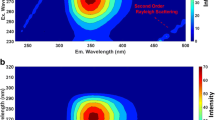Abstract
Excitation-emission matrix fluorescence (EEMF) and total synchronous fluorescence spectroscopy (TSFS) are the 2 fluorescence techniques that are commonly used for the analysis of multifluorophoric mixtures. These 2 fluorescence techniques are conceptually different and provide certain advantages over each other. The manual analysis of such highly correlated large volume of EEMF and TSFS towards developing a calibration model is difficult. Partial least square (PLS) analysis can analyze the large volume of EEMF and TSFS data sets by finding important factors that maximize the correlation between the spectral and concentration information for each fluorophore. However, often the application of PLS analysis on entire data sets does not provide a robust calibration model and requires application of suitable pre-processing step. The present work evaluates the application of genetic algorithm (GA) analysis prior to PLS analysis on EEMF and TSFS data sets towards improving the precision and accuracy of the calibration model. The GA algorithm essentially combines the advantages provided by stochastic methods with those provided by deterministic approaches and can find the set of EEMF and TSFS variables that perfectly correlate well with the concentration of each of the fluorophores present in the multifluorophoric mixtures. The utility of the GA assisted PLS analysis is successfully validated using (i) EEMF data sets acquired for dilute aqueous mixture of four biomolecules and (ii) TSFS data sets acquired for dilute aqueous mixtures of four carcinogenic polycyclic aromatic hydrocarbons (PAHs) mixtures. In the present work, it is shown that by using the GA it is possible to significantly improve the accuracy and precision of the PLS calibration model developed for both EEMF and TSFS data set. Hence, GA must be considered as a useful pre-processing technique while developing an EEMF and TSFS calibration model.




Similar content being viewed by others
References
Freegarde M, Hatchard CG, Parker CA (1971) Oil spilt at sea: its identification, determination, and ultimate fate. Lab Pr 20:35–40
Warner IM, Callis JB, Davidson ER, Goutermann M, Christian GD (1975) Fluorescence analysis: a new approach. Anal Lett 8:665–681
Rho JH, Stuart JL (1978) Automated three-dimensional plotter for fluorescence measurements. Anal Chem 50:620–625
Kumar K, Tarai M, Mishra AK (2017) Unconventional steady-state fluorescence spectroscopy as an analytical technique for analyses of complex-multifluorophoric mixtures. TrAC Trends Anal Chem 97:216–243
Kumar K, Mishra AK (2013) Analysis of dilute aqueous multifluorophoric mixtures using excitation-emission matrix fluorescence (EEMF) and total synchronous fluorescence (TSF) spectroscopy: a comparative evaluation. Talanta 117:209–220
Patra D, Mishra AK (2002) Total synchronous fluorescence scan spectra of petroleum products. Anal Bioanal Chem 373:304–309
Kumar K, Mishra AK (2012) Application of ‘multivariate curve resolution alternating least square (MCR–ALS)’ analysis to extract pure component synchronous fluorescence spectra at various wavelength offsets from total synchronous fluorescence spectroscopy (TSFS) data set of dilute aqueous solutions of fluorophores. Chemom Intell Lab Syst 116:78–86
Kumar K, Mishra AK (2012) Application of parallel factor analysis to total synchronous fluorescence spectrum of dilute multifluorophoric solutions: addressing the issue of lack of trilinearity in total synchronous fluorescence data set. Anal Chim Acta 755:37–45
Kramer R (1998) Chemometric techniques for quantitative analysis. Marcel Dekker, New York
Wold S, Ruhe A, Wold H, Dunn WJ (1984) The collinearity problem in linear regression. The partial least squares (PLS) approach to generalized inverses. SIAM J Sci and Stat Comp 5:735–743
Geladi P, Kowalski B (1986) Partial least square regression: a tutorial. Anal Chim Acta 185:1–17
Lorber A, Wangen LE, Kowalski BR (1987) A theoretical foundation for the PLS algorithm. J Chemom 1:19–31
Varmuza K, Filzmoser P (2008) Introduction to multivariate statistical analysis in chemometrics, Taylor & Francis Group, Boca Raton, FL
Kumar K, Mishra AK (2012) Quantification of ethanol in ethanol-petrol and biodiesel in biodiesel-diesel blends using fluorescence spectroscopy and multivariate methods. J Fluoresc 22:339–347
Wise BM, Gallaghar NB, Bro R, Shaver JM (2006) PLS_Toolbox 4.0. Eigen vector research
Bangalore AS, Shaffer RE, Small GW (1996) Genetic algorithm-based method for selecting wavelengths and model size for use with partial least-squares regression: application to near-infrared spectroscopy. Anal Chem 68:4200–4212
Xiaobo Z, Jiewen Z, Hanpin M, Jiyong S, Xiaopin Y, Yanxiao L (2010) Genetic algorithm interval partial least squares regression combined successive projections algorithm for variable selection in near-infrared quantitative analysis of pigment in cucumber leaves. Appl Spec 64:786–794
Leardi R, González AL (1998) Genetic algorithms applied to feature selection in PLS regression: how and when to use them. Chemom Intell Lab Syst 41:195–207
Sorol N, Arancibia E, Bortolato SA, Olivieri AC (2010) Visible/near infrared-partial least-squares analysis of brix in sugar cane juice A test field for variable selection methods. Chemom Intell Lab Syst 102:100–109
Goicoechea HC, Olivier AC (2003) A new family of genetic algorithms for wavelength interval selection in multivariate analytical spectroscopy. J Chemom 17:338–345
Mehmood T, Liland KH, Snipen L, Sæbø S (2012) A review of variable selection methods in partial least squares regression. Chemom Intell Lab Syst 118(2012):62–69
Shaffer RE, Small GW (1996) Genetic algorithm-based protocol for coupling digital filtering and partial least-squares regression: application to the near-infrared analysis of glucose in biological matrices. Anal Chem 68:2663–2675
Ding Q, Small GW (1998) Genetic algorithm-based wavelength selection for the near-infrared determination of glucose in biological matrixes: initialization strategies and effects of spectral resolution. Anal Chem 70:4472–4479
Bro R, Rinnan Å, Flaber NM (2005) Standard error of pediction for multilinear PLS 2. Practical implementation in fluorescence spectroscopy. Chemom Intell Lab Syst 75:69–76
Rinnan Å (2004) Application of PARAFAC on spectral data. Royal Veterinary and Agricultural University-DK, PhD Thesis
Acknowledgements
Keshav Kumar thanks Professor A.K. Mishra, Department of Chemistry, Indian Institute of Technology-Madras, India, for his valuable inputs in this work.
Author information
Authors and Affiliations
Corresponding author
Electronic supplementary material
ESM 1
(DOCX 20 kb)
Rights and permissions
About this article
Cite this article
Kumar, K. Application of Genetic Algorithm (GA) Assisted Partial Least Square (PLS) Analysis on Trilinear and Non-trilinear Fluorescence Data Sets to Quantify the Fluorophores in Multifluorophoric Mixtures: Improving Quantification Accuracy of Fluorimetric Estimations of Dilute Aqueous Mixtures. J Fluoresc 28, 589–596 (2018). https://doi.org/10.1007/s10895-018-2221-8
Received:
Accepted:
Published:
Issue Date:
DOI: https://doi.org/10.1007/s10895-018-2221-8




